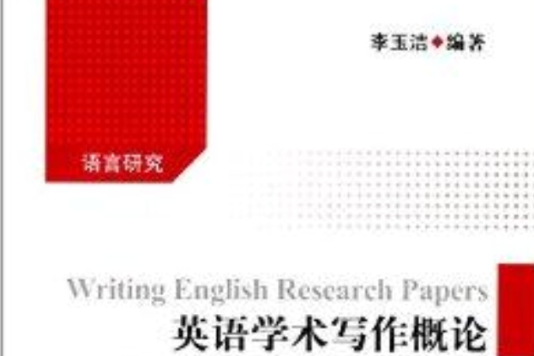內容簡介
《語言研究:英語學術寫作概論》從直觀性和實用性的角度出發,詳盡地介紹了英語學術寫作的基本原則,寫作步驟和標準格式。全書共分9章:第1、2章簡要介紹了學術論文的特點和結構,以及
論文寫作的一般步驟;第3章探討了如何寫“文獻回顧”;第4章介紹了學術研究中,尤其是實證研究中收集數據的方法;第5、6、7章介紹了學術論文的語言特點和風格,寫作技巧和論文摘要的重要性;第8、9章介紹了引文和參考文獻的常用格式。《語言研究:英語學術寫作概論》集科學性、知識性和可讀性為一體,內容豐富,信息量大,對科研人員以及大學生和研究生的論文寫作起到了啟迪、借鑑作用。
圖書目錄
Chapter 1 Introduction
1.1 Characteristics of a research paper
1.2 Types of research papers
1.3 The structure of a research paper
1.3.1 The front matter
1.3.1.1 Title page
1.3.1.2 Outline page
1.3.1.3 Abstract
1.3.2 The body
1.3.2.1 Introduction
1.3.2.2 Literature review
1.3.2.3 Writing the conclusion
1.3.3 The back matter
1.3.3.1 References
1.3.3.2 Appendices
Chapter 2 The Process of Writing a Research Paper
2.1 Choosing a topic
2.2 Exploring sources
2.3 Evaluating resources
2.4 Outlining the paper
2.4.1 Topic outline
2.4.2 Sentence outline
2.5 Writing the first draft
2.6 Revising and editing
2.7 Proofreading
Chapter 3 Literature Review
3.1 Components of literature review
3.2 Mistakes in writing a literature review
3.3 Examples of good literature reviews
Chapter 4 Methodology
4.1 Qualitative approach
4.2 Quantitative approach
4.3 Ways to collect data
4.3.1 Interview
4.3.2 Questionnaire
Chapter 5 Language and Style
5.1 Diction
5.1.1 Avoid colloquialisms
5.1.2 Avoid personalization
5.1.3 Avoid gender limitations
5.1.4 Avoid using the same word repeatedly
5.2 Sentence structure
5.2.1 Parallelism
5.2.1.1 Balanced parallel ideas in a series
5.2.1.2 Balanced parallel ideas presented as pairs
5.2.2 Shifts
5.2.2.1 Make the point of view consistent
5.2.2.2 Make verbs consistent in mood and voice
5.2.2.3 Avoid sudden shifts from indirect to direct questions or quotations
5.2.3 Sentence variety
5.2.3.1 Use a variety of sentence structures
5.2.3.2 Use a variety of sentence openings
5.2.3.3 Try inverting sentences occasionally
Chapter 6 Mechanics
6.1 Abbreviations
6.1.1 Social and professional titles & similar terms
6.1.2 Organizations
6.2 Units of measurement
6.3 Titles of works
6.4 Numbers
6.4.1 Use of words of numerals
6.4.2 Punctuation of numbers
6.4.3 Decimals and percentage
Chapter 7 Abstract
7.1 Reasons of making up an abstract
7.2 Elements of an abstract
7.3 qhe relationships between an abstract text and a research text
7.4 Samples of abstract
Chapter 8 Documentation
8.1 Supporting a thesis
8.1.1 Use sources to inform and support your argument
8.1.1.1 Providing background information or context
8.1.1.2 Explaining terms or concepts
8.1.1.3 Supporting your claims
8.1.1.4 Lending authority to your argument
8.2 Citing sources and avoiding plagiarism
8.2.1 Cite quotation and borrowed ideas
8.2.2 Enclose borrowed language in quotation marks
8.2.3 Put summaries and paraphrases in your own words
8.2.4 Plagiarism: unacceptable borrowing
8.3 Integrating sources
8.3.1 Limit your use of quotations
8.3.1.1 Using the ellipsis mark and brackets
8.3.1.2 Setting off long quotations
8.3.2 Use signal phrases to integrate sources
8.3.2.1 Using signal phrases in MLA papers
8.3.2.2 Marking boundaries
8.3.2.3 Establishing authority
8.3.2.4 Introducing summaries and paraphrases
8.3.2.5 Putting direct quotations in context
8.3.2.6 Integrating statistics and other facts
Chapter 9 Documenting sources: Modern Language Association (MLA) Style
9.1 MLA in—text citations
9.2 Basic rules for print and electronic sources
9.3 Variation on the basic rules
9.4 MLA list of works cited
9.4.1 General guidelines for listing authors
9.4.2 Basic format for a book
9.4.3 Articles in periodicals
9.4.4 Online sources
9.5 Alphabetizing the list
9.5.1 Indenting
9.5.2 Web addresses
Bibliography

